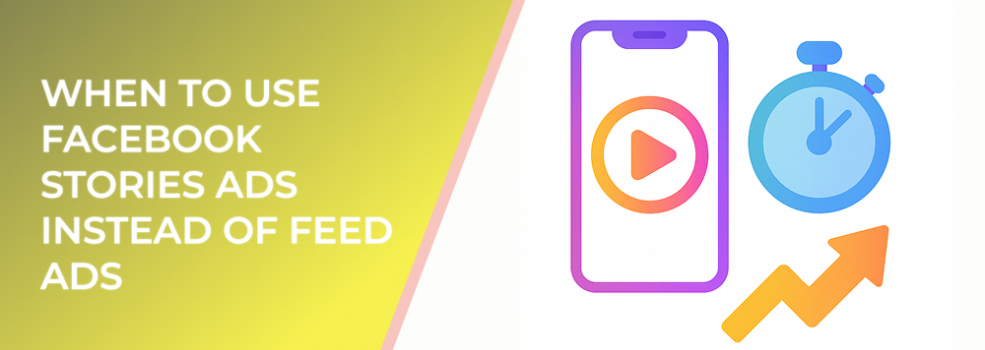Feed placements are built for lean-back browsing and depth (copy, comments, longer videos). Stories are full-screen, sound-on friendly, swipeable, and disappear after 24 hours. That makes Stories ideal for quick hooks, visuals, and simple actions—provided you design for speed and vertical creative.
Useful statistics at a glance
-
Attention window: Median view duration in Stories is typically 1.5–3.0 seconds before the first swipe; Feeds commonly allow 3–8 seconds of passive viewing on the same audience size and spend.
-
CPM/Reach: Stories CPMs are often 10–35% lower than Feeds in many accounts, generating broader reach per dollar—especially for broad audiences and lightweight objectives.
-
Link actions: Tap/Swipe-through rates in Stories can be 20–60% higher than Feed link CTR when the CTA is simple (e.g., View Product, Download App), but can underperform for complex forms.
-
Creative fatigue: Stories creatives fatigue faster; frequency > 3 in 7 days often drops swipe-through by 15–30%.
Ranges reflect common patterns observed across ecommerce and lead‑gen accounts; impact varies by vertical, audience, and offer complexity.
When to use Stories instead of Feed
1) You have vertical-native creative (9:16) with a single, simple action
Quick product reveals, app demos, and before/after flashes suit Stories. If your CTA is “shop now,” “install,” or “DM,” Stories can win on cost per click and cost per add‑to‑cart.
2) Launches, drops, and time-bound offers
Ephemeral context plays well in ephemeral placements. Flash sales, limited runs, restocks, and event reminders earn fast attention in Stories and benefit from broad reach.
3) UGC and influencer clips
Self-recorded vertical clips with captions feel native to Stories. Use 6–10 second cuts with on-screen text and big, tappable CTAs.
4) Low-friction conversions
If your conversion path is short—product page → checkout, app store install, or lead form with 3–4 fields—Stories can drive more attempts at lower cost.
5) Creative testing at scale
Because CPMs are often cheaper, Stories help you test more hook concepts quickly and move winners to Feeds/IG Reels if they sustain quality.
6) Brand motion moments
Motion graphics, quick montage, and sound-reactive cuts deliver higher thumb‑stop in Stories than static Feed posts.
When Feeds still win
-
Complex or high-ticket offers that need depth, long copy, comments, and social proof.
-
Detailed comparisons or multi‑step explanations (case studies, specs, pricing tables).
-
Longer consideration cycles where you want deliberate scrolling, saves, and comment Q&A.
How to build Stories that outperform
Creative principles
-
9:16 full-screen; safe area respected (keep core elements away from top/bottom UI zones).
-
Hook in 0–2 seconds with motion and captions (assume sound off, reward sound on).
-
One idea per frame; 6–10 seconds total. Use clear, high-contrast CTAs.
-
Design placement-aware versions rather than simply cropping Feed assets.
Offer & CTA
-
Simple, actionable offers: “Shop the drop,” “Book today,” “Get the guide,” “Install now.”
-
Use price or incentive cues sparingly but clearly (free shipping, % off, time left).
Landing path
-
Mobile-first pages, <3s load, above-the-fold proof, and a single primary CTA.
-
For lead gen, keep forms to 3–5 qualifying questions; use a calendar handoff on the thank‑you page.
Cadence & fatigue
-
Rotate new Story variants weekly at scale; watch frequency and swipe-through.
-
Cap total live Story ads per ad set at ≤6 to avoid learning dilution.
Campaign setup tips
-
Objectives: Use Sales, App Promotion, or Leads; avoid optimizing to link clicks for most performance goals.
-
Budgeting: Start with a Stories-only ad set if you want clean readouts; later, test Auto Placements vs Stories-only to verify incrementality.
-
Measurement: Keep the attribution window constant. Track cost per add‑to‑cart/install/qualified lead and purchase value, not just CTR.
-
Audiences: Broad works well with strong creative; add exclusions (customers, recent buyers). For retargeting, limit recency (e.g., 14–30 days) to protect frequency.
A 10‑day Stories playbook
Day 1–2: Ship 3 vertical concepts (UGC demo, motion montage, offer-first).
Day 3–4: No edits; monitor swipe-through and cost per key event.
Day 5: Prune the worst performer (>40% above cohort CPA).
Day 6–7: Iterate the best hook with a new opening 2 seconds.
Day 8–10: Scale +15–20% if cost per purchase/lead holds; add a Feed control ad set to compare.
Troubleshooting: Stories underperform—now what?
-
Placement skew: Are impressions falling mostly on a single creative? Cap ads and diversify hooks.
-
Hook weakness: If 3‑sec hold is low, reshoot the first 2 seconds with movement and captions.
-
Path friction: If swipe-through is solid but adds to cart are low, fix product page speed and clarity.
-
Form junk: If leads are cheap but low quality, add 1–2 disqualifier questions and adjust the CTA to repel the wrong audience.
Executive summary
Use Facebook Stories ads when you have vertical-native video, a simple ask, and a mobile-first path to conversion. Expect cheaper reach and faster testing, but manage fatigue, keep CTAs simple, and verify incrementality against a Feed control.

